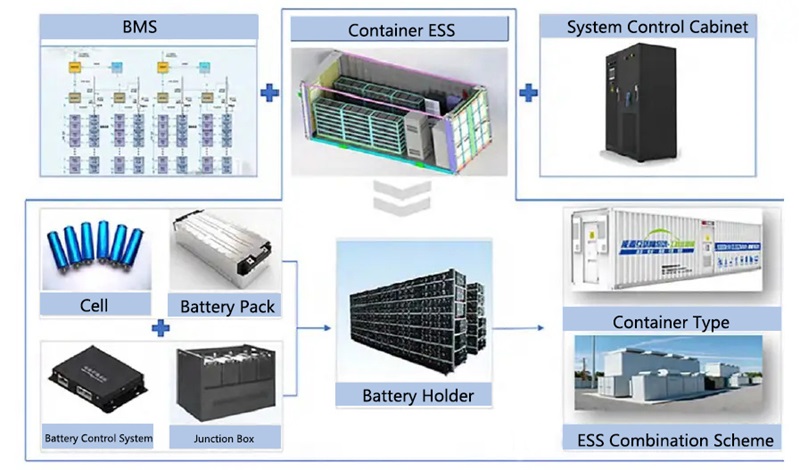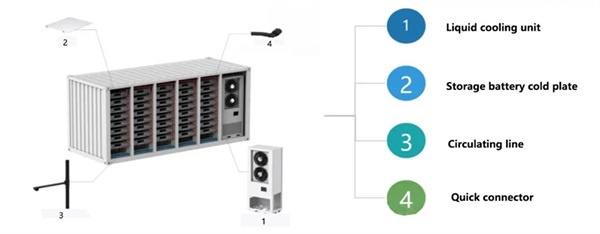Liquid Cooling Energy Storage System: Intelligent Solutions for Efficient Energy Management of Lithium Ion Battery
With the advancement of lithium ion battery technology and the reduction of cost, large-scale lithium ion battery energy storage power stations are gradually moving from demonstration to commercial application. The optimized design of battery thermal management system is the key technology to improve the integrated performance of energy storage system. Temperature acontrol can not only effectively extend the life of energy storage battery, discharge capacity and other performance, but also ensure the safe operation of the power station. As the carrier of large-scale electrochemical energy storage power station, wire transfer has urgent thermal safety problems.
Composition of the Energy Storage System

The bidirectional energy storage inverter energy storage system consists of a battery, electrical components, mechanical support, a heating and cooling system (thermal management system), a power conversion system (PCS), an energy management system (EMS), and a battery management system (BMS). The batteries are arranged and assembled into battery modules, which are then fixed and assembled together with other components into a battery cabinet.
Impact of Temperature on Cell Performance
The effects of temperature primarily manifest in the following aspects:
1. Capacity: High temperatures can lead to increased internal resistance in batteries and the loss of active lithium ions. Prolonged exposure to high temperatures can cause the battery capacity to deviate significantly from its rated capacity. The higher the temperature, the faster the capacity decay of lithium-ion batteries. In low-temperature environments, the transport performance of the electrolyte decreases significantly, leading to reduced battery capacity. For lifepo4 battery cell, the capacity retention at 0°C is 60% to 70%, while at -20°C it drops to 20% to 40%.
2. Lifetime: Temperature variations can lead to changes in internal resistance and voltage, affecting battery lifespan. Research shows that for every 1°C increase in temperature, the battery life decreases by approximately 60 days.
3. Thermal Stability: High temperatures can cause the internal materials of the battery to undergo decomposition reactions, impacting the safe and stable operation of the battery. In high-temperature environments, the solid electrolyte interphase (SEI) film may decompose, potentially leading to blockage of lithium ion pathways, short circuits between the positive and negative electrodes, and excessive heat generation. This can also result in the generation of a large amount of gas, leading to battery swelling, rupture, and thermal runaway. Conversely, in low-temperature environments, lithium dendrites may form on the negative electrode, which can even pierce the SEI film, compromising battery safety.

It is currently widely believed that the optimal operating temperature range for lithium batteries is 10-35°C
Liquid Cooling Solutions Becoming a Mainstream Trend
Currently, there are thermal management solutions in the energy storage field, including air cooling and liquid cooling. Analysis suggests that by 2025, the domestic market value for temperature control in energy storage will reach 16.5 billion yuan. As energy storage capacity and charge-discharge rates improve, the proportion of medium to high-power energy storage products utilizing liquid cooling will gradually increase, making liquid cooling a likely mainstream solution in the future, with a projected penetration rate of about 45% by 2025.
Industry experts believe that air cooling, which uses fans to dissipate heat generated by the cells, has advantages such as simple structure and low cost. However, it has a low heat transfer coefficient, slower cooling speed, and requires large heat dissipation channels, resulting in relatively high energy consumption. In contrast, liquid cooling utilizes coolant for convective heat transfer, effectively lowering battery temperatures with higher thermal conductivity and more uniform cooling, leading to lower energy consumption. Liquid cooling can be further divided into cold plate cooling and immersion cooling.
Air cooling relies on natural airflow or air conditioning systems to dissipate heat from the batteries. While it has a simple structure and is easy to install, it has low cooling efficiency, uneven heat dissipation, and significant temperature differences between battery packs (ranging from 4° to 8°C).
Composition of Air-Cooled Energy Storage Solutions

Cold plate liquid cooling involves placing cooling plates, filled with circulating coolant, beneath the battery cellsto cool the contact areas. The coolant does not directly contact the cells, making it an indirect cooling method, which suffers from slow cooling speeds and prolonged cooling times. Both cooling methods lack the ability to significantly lower the temperature of the cells and reduce the temperature differences during operation.
Composition of Cold Plate Energy Storage Solutions

Immersion liquid cooling involves directly immersing energy storage batteries in coolant, allowing direct contact between the cells and the coolant. This method effectively isolates the cells from oxygen and achieves direct, rapid, and thorough cooling, ensuring that the batteries operate within the optimal temperature range, thereby extending battery life and enhancing the overall safety performance of the energy storage station.
"Three Stages" of Thermal Management in Energy Storage Systems
Stage 1: Before 2021, the energy storage market was dominated by air cooling. In this phase, air is used as a medium via air conditioning systems to circulate continuously through the battery packs, relying on the temperature difference between the battery modules and the air for heat transfer. The downside is poor cooling performance, mainly applicable to small residential or commercial energy storage stations.
Stage 2: From 2021 to the present, cold plate liquid cooling technology has surged, with market share steadily increasing. Liquid cooling uses liquid as the heat transfer medium, which has a higher specific heat capacity and thermal conductivity than air, allowing for rapid cooling and significantly improving consistency in battery module temperatures while effectively reducing peak temperatures. Consequently, liquid cooling has garnered increasing attention in the industry.
Stage 3: Cold plate liquid cooling and air cooling are now seen as equally viable, while full immersion liquid cooling holds significant potential. Traditional cold plate liquid cooling technology has its limitations because the main heat-generating areas of the cells are the tab connections. The cooling plates in cold plate systems are located at the bottom of the cells, which cannot directly cool the tabs. Currently, achieving direct cooling of the tabs with liquid cooling plates is challenging, as it may affect the temperature and voltage measurement and collection of the cells.

